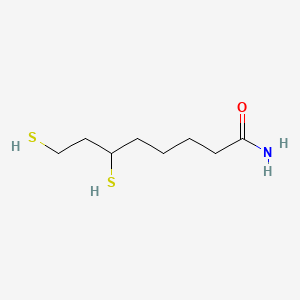| MeSH term | MeSH ID | Detail |
|---|---|---|
| Parkinsonian Disorders | D020734 | 20 associated lipids |
Dihydrolipoamide
Dihydrolipoamide is a lipid of Fatty Acyls (FA) class. Dihydrolipoamide is associated with abnormalities such as Wiskott-Aldrich Syndrome. The involved functions are known as Citric Acid Cycle, Electron Transport, NADH oxidation, Oxidation and Oxidants. Dihydrolipoamide often locates in Mitochondria, Mitochondrial matrix and Chloroplasts. The associated genes with Dihydrolipoamide are Mutant Proteins, Recombinant Proteins, mycothione reductase, Genes, Mitochondrial and alanylproline.
Cross Reference
Introduction
To understand associated biological information of Dihydrolipoamide, we collected biological information of abnormalities, associated pathways, cellular/molecular locations, biological functions, related genes/proteins, lipids and common seen animal/experimental models with organized paragraphs from literatures.
What diseases are associated with Dihydrolipoamide?
Dihydrolipoamide is suspected in and other diseases in descending order of the highest number of associated sentences.
Related references are mostly published in these journals:
| Disease | Cross reference | Weighted score | Related literature |
|---|
Possible diseases from mapped MeSH terms on references
We collected disease MeSH terms mapped to the references associated with Dihydrolipoamide
PubChem Associated disorders and diseases
What pathways are associated with Dihydrolipoamide
There are no associated biomedical information in the current reference collection.
PubChem Biomolecular Interactions and Pathways
Link to PubChem Biomolecular Interactions and PathwaysWhat cellular locations are associated with Dihydrolipoamide?
Visualization in cellular structure
Associated locations are in red color. Not associated locations are in black.
Related references are published most in these journals:
| Location | Cross reference | Weighted score | Related literatures |
|---|
What functions are associated with Dihydrolipoamide?
Related references are published most in these journals:
| Function | Cross reference | Weighted score | Related literatures |
|---|
What lipids are associated with Dihydrolipoamide?
There are no associated biomedical information in the current reference collection.
What genes are associated with Dihydrolipoamide?
Related references are published most in these journals:
| Gene | Cross reference | Weighted score | Related literatures |
|---|
What common seen animal models are associated with Dihydrolipoamide?
There are no associated biomedical information in the current reference collection.
NCBI Entrez Crosslinks
All references with Dihydrolipoamide
Download all related citations| Authors | Title | Published | Journal | PubMed Link |
|---|---|---|---|---|
| Li W et al. | Proteomic analysis of metabolic, cytoskeletal and stress response proteins in human heart failure. | 2012 | J. Cell. Mol. Med. | pmid:21545686 |
| Deres P et al. | Prevention of doxorubicin-induced acute cardiotoxicity by an experimental antioxidant compound. | 2005 | J. Cardiovasc. Pharmacol. | pmid:15613977 |
| Raddatz G and Bisswanger H | Receptor site and stereospecifity of dihydrolipoamide dehydrogenase for R- and S-lipoamide: a molecular modeling study. | 1997 | J. Biotechnol. | pmid:9383983 |
| Li M et al. | Effect of lpdA gene knockout on the metabolism in Escherichia coli based on enzyme activities, intracellular metabolite concentrations and metabolic flux analysis by 13C-labeling experiments. | 2006 | J. Biotechnol. | pmid:16310273 |
| Chi F et al. | Identification of IbeR as a stationary-phase regulator in meningitic Escherichia coli K1 that carries a loss-of-function mutation in rpoS. | 2009 | J. Biomed. Biotechnol. | pmid:19300523 |
| Matthews RG | A love affair with vitamins. | 2009 | J. Biol. Chem. | pmid:19596855 |
| Sahlman L and Williams CH | Lipoamide dehydrogenase from Escherichia coli. Steady-state kinetics of the physiological reaction. | 1989 | J. Biol. Chem. | pmid:2498307 |
| Brautigam CA et al. | Structural and thermodynamic basis for weak interactions between dihydrolipoamide dehydrogenase and subunit-binding domain of the branched-chain alpha-ketoacid dehydrogenase complex. | 2011 | J. Biol. Chem. | pmid:21543315 |
| Hall BS et al. | Nifurtimox activation by trypanosomal type I nitroreductases generates cytotoxic nitrile metabolites. | 2011 | J. Biol. Chem. | pmid:21345801 |
| Vaubel RA et al. | Mutations in the dimer interface of dihydrolipoamide dehydrogenase promote site-specific oxidative damages in yeast and human cells. | 2011 | J. Biol. Chem. | pmid:21930696 |
| Islam MM et al. | A novel branched-chain amino acid metabolon. Protein-protein interactions in a supramolecular complex. | 2007 | J. Biol. Chem. | pmid:17314104 |
| Smolle M et al. | A new level of architectural complexity in the human pyruvate dehydrogenase complex. | 2006 | J. Biol. Chem. | pmid:16679318 |
| Ciszak EM et al. | How dihydrolipoamide dehydrogenase-binding protein binds dihydrolipoamide dehydrogenase in the human pyruvate dehydrogenase complex. | 2006 | J. Biol. Chem. | pmid:16263718 |
| Foster MW and Stamler JS | New insights into protein S-nitrosylation. Mitochondria as a model system. | 2004 | J. Biol. Chem. | pmid:15069080 |
| Petrat F et al. | Reduction of Fe(III) ions complexed to physiological ligands by lipoyl dehydrogenase and other flavoenzymes in vitro: implications for an enzymatic reduction of Fe(III) ions of the labile iron pool. | 2003 | J. Biol. Chem. | pmid:12963736 |
| Rahmatullah M and Roche TE | Component requirements for NADH inhibition and spermine stimulation of pyruvate dehydrogenaseb phosphatase activity. | 1988 | J. Biol. Chem. | pmid:2836411 |
| O'Connor TP et al. | 13C nuclear magnetic resonance study of the pyruvate dehydrogenase-catalyzed acetylation of dihydrolipoamide. | 1982 | J. Biol. Chem. | pmid:6801041 |
| Rocheleau JV et al. | Quantitative NAD(P)H/flavoprotein autofluorescence imaging reveals metabolic mechanisms of pancreatic islet pyruvate response. | 2004 | J. Biol. Chem. | pmid:15148320 |
| Hiromasa Y et al. | Organization of the cores of the mammalian pyruvate dehydrogenase complex formed by E2 and E2 plus the E3-binding protein and their capacities to bind the E1 and E3 components. | 2004 | J. Biol. Chem. | pmid:14638692 |
| MacDonald MJ et al. | Immunochemical identification of coenzyme Q0-dihydrolipoamide adducts in the E2 components of the alpha-ketoglutarate and pyruvate dehydrogenase complexes partially explains the cellular toxicity of coenzyme Q0. | 2004 | J. Biol. Chem. | pmid:15075342 |
